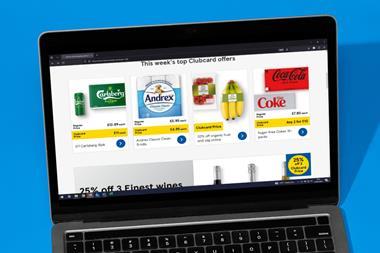Although both can argue strongly for their respective strategies, they have their limitations. While Tesco.com may be slightly profitable, when volumes increase, the picking of goods instore will ultimately interfere with the day-to-day running of its stores and a warehouse will be needed. And while Ocado has the scope to dramatically scale up its operation as well as remove the pointless step of having goods delivered to stores before they are delivered to customers' homes, it is a long way from profitability because its volumes are small.
John Browett, chief executive of Tesco.com, says: "It is too early for us to have a warehouse as our volumes are not high enough so it will not work."
Annual sales at Tesco.com are expected to hit £500m this year but Browett believes that between £2bn and £3bn of sales could be achieved by instore picking before Tesco.com needs to adopt a warehouse strategy. He adds: "Unless there is a dramatic change in the market it will take time to get there."
Will Treasure, director of home shopping consultancy Javelin Group, calculates that at about 5,000 orders a week a warehouse could become "roughly competitive" against an instore picking method.
With Tesco.com probably taking approaching 100,000 orders a week nationally, Treasure's calculation suggests its volumes are capable of supporting a 20-warehouse operation compared with the 300 superstores it uses for instore picking. But this would increase transport costs and so a strategy of introducing warehouses in locations of high volumes is more likely.
This would also ensure each warehouse operates at something like full capacity.
This is not the case with Ocado. Unlike Tesco.com, which can gradually move its business over to warehouses when it reaches critical mass in various locations, Ocado has committed to grow its business in a mighty purpose-built 300,000 sq ft distribution warehouse in Hatfield, Hertfordshire.
Risky strategy
This has the capacity to deliver up to 60,000 orders a week, but presently operates on only about 5,000-plus a week. These numbers certainly make it look a risky strategy and lead Browett to hold reservations about the potential for warehouse distribution to pay its way over the next few years. "The track record is not good. Eleven companies in the US have tried it and failed, and they are sharp in the US," he says.
In the UK there have also been a few high-profile failures. Sainsbury closed one of its warehouses and now runs a hybrid service using only one depot. Asda threw in the towel and closed its two warehouses while Iceland terminated the delivery service from its Booker distribution centres to concentrate on delivering from its stores.
Crucial to making warehouses work is the drop density' the number of deliveries made within a square mile over a specific time frame. Combining this with a low stem mileage' the length of journey undertaken to reach the first drop makes it hard to get the numbers to stack up for a warehouse. This is because they obviously have a larger catchment area than a store and this is likely to lead to longer runs for its vans.
Browett says: "You need lots of vans delivering to lots of people to get a high drop density, and that is difficult to achieve because, if say there is an accident on the M1 or M25, then you're stuffed. This is a local delivery business and I'm glad we got our calculations right on this."
However, Roger Whiteside and Nigel Robertson, joint managing directors of Ocado, believe they have the solution with their innovative hub and spoke' system. This involves a number of spokes' embarkation points to where refrigerated pods' are delivered by articulated lorries that can each carry up to six pods. Each pod is loaded onto individual delivery vans for local deliveries to customers.
The first spoke is at Weybridge, in Surrey, and will be followed by a second later this year to serve the south-east section of the M25, giving Ocado full reach within the motorway boundary.
Complex routing and scheduling software that the company has had custom-made by specialist logistics company Descartes helps to run this system. But Browett still remains sceptical: "We may have missed something, but there seems nothing new about it to us."
This is not the case according to the Ocado pair because, in contrast to the other warehouse-based operators that built expensive secondary warehouses, the simple spoke system removes the need for any unnecessary extra handling. Whiteside acknowledges Ocado will need up to five large warehouses on the scale of Hatfield in order to give it full national coverage, but he says this will not be done for some time.
Small scale
Like everything at Ocado its spoke system is still working on a very small scale. There are only six lorries in use with the capability of making two journeys a day from Hatfield to Weybridge. The bulk of the 1,000-plus daily orders are fulfilled directly from Hatfield in the 160 vans the company has at its disposal each of which can hold an average of 17 orders of an average value of £100.
The plan is to grow slowly but surely so that while scaling up the business the service levels can be maintained because this is where Ocado believes it has a competitive advantage over its rivals such as Tesco.com with their store-picking models.
The Descartes software gives Ocado the ability to offer one-hour delivery time slots compared with Tesco.com and the other supermarkets that offer two-hour time slots. And Ocado says it delivers between 97% and 98% of its orders within the stated time. In addition, Robertson says that out-of-stocks for the likes of Tesco.com could be as high as 10% to 20% of an order compared with Ocado where it is only 2%. This is possible because of the real-time link between its warehouse and the Ocado website.
Treasure says: "It is definitely a competitive advantage, but how big is open to debate. Ocado's warehouse view needs to be very accurate and with single item picking of food products this is hard to achieve."
While Browett argues that availability on Tesco.com is "very, very high" he believes it is the quality of the substitutions that are most important. "Even with a warehouse it is impossible to get 100% availability because suppliers will still let you down and trucks will not turn up," he says.
Certainly judging by The Grocer 33 Online quarterly shopping survey from earlier this year, problems with stocking and substitutions were in evidence at all the supermarkets' home shopping operations.
While there is general agreement that warehouses will be the most efficient way to fulfil grocery home shopping orders in the future, Ocado is paying a heavy price to be in the game right now. It has raised £130m, including from the Union Bank of Switzerland, Waitrose parent John Lewis which owns a 40% stake and two former employees of Goldman Sachs, one being Tim Steiner, chief executive officer of Ocado. It has spent £90m and, according to a source close to the company, the operation's running costs are between £500,000 and £1m a week.This is in stark contrast to Tesco.com which is making a small profit on its £45m dotcom investment. "The capital investment is tiny compared to anybody that is doing it any other way," says Browett.
And the spending looks to be far from over at Ocado. On the basis that its remaining money will be used by the end of the year, its investors will no doubt be dipping into their pockets a few more times before they see any return. Treasure says the challenge for Ocado is how long it takes to achieve profitability and whether it has sufficient cash to do so? "It is a great operation but hard to make profitable," he says.
Whiteside counters: "We've planned when we would require an injection of money and it has gone according to plan. The investors know the timetable but because it is sensitive we cannot say when breakeven will be."
Whiteside is, however, willing to admit that Ocado is something of a walk into the unknown because nobody has done it before and the other supermarkets are watching avidly from the sidelines.
"There is no dispute, everybody agrees that, at scale, you can centralise and draw economies. What is unproved is how you actually do it and how big those economies of scale will be before it starts to pay? We have our theories," says Whiteside.
Many others probably do too, but it is Ocado that is landing the first punches and keeping people guessing whether its investors have deep enough pockets to keep them standing at the end of this bruising bout.
{{ANALYSIS }}
John Browett, chief executive of Tesco.com, says: "It is too early for us to have a warehouse as our volumes are not high enough so it will not work."
Annual sales at Tesco.com are expected to hit £500m this year but Browett believes that between £2bn and £3bn of sales could be achieved by instore picking before Tesco.com needs to adopt a warehouse strategy. He adds: "Unless there is a dramatic change in the market it will take time to get there."
Will Treasure, director of home shopping consultancy Javelin Group, calculates that at about 5,000 orders a week a warehouse could become "roughly competitive" against an instore picking method.
With Tesco.com probably taking approaching 100,000 orders a week nationally, Treasure's calculation suggests its volumes are capable of supporting a 20-warehouse operation compared with the 300 superstores it uses for instore picking. But this would increase transport costs and so a strategy of introducing warehouses in locations of high volumes is more likely.
This would also ensure each warehouse operates at something like full capacity.
This is not the case with Ocado. Unlike Tesco.com, which can gradually move its business over to warehouses when it reaches critical mass in various locations, Ocado has committed to grow its business in a mighty purpose-built 300,000 sq ft distribution warehouse in Hatfield, Hertfordshire.
Risky strategy
This has the capacity to deliver up to 60,000 orders a week, but presently operates on only about 5,000-plus a week. These numbers certainly make it look a risky strategy and lead Browett to hold reservations about the potential for warehouse distribution to pay its way over the next few years. "The track record is not good. Eleven companies in the US have tried it and failed, and they are sharp in the US," he says.
In the UK there have also been a few high-profile failures. Sainsbury closed one of its warehouses and now runs a hybrid service using only one depot. Asda threw in the towel and closed its two warehouses while Iceland terminated the delivery service from its Booker distribution centres to concentrate on delivering from its stores.
Crucial to making warehouses work is the drop density' the number of deliveries made within a square mile over a specific time frame. Combining this with a low stem mileage' the length of journey undertaken to reach the first drop makes it hard to get the numbers to stack up for a warehouse. This is because they obviously have a larger catchment area than a store and this is likely to lead to longer runs for its vans.
Browett says: "You need lots of vans delivering to lots of people to get a high drop density, and that is difficult to achieve because, if say there is an accident on the M1 or M25, then you're stuffed. This is a local delivery business and I'm glad we got our calculations right on this."
However, Roger Whiteside and Nigel Robertson, joint managing directors of Ocado, believe they have the solution with their innovative hub and spoke' system. This involves a number of spokes' embarkation points to where refrigerated pods' are delivered by articulated lorries that can each carry up to six pods. Each pod is loaded onto individual delivery vans for local deliveries to customers.
The first spoke is at Weybridge, in Surrey, and will be followed by a second later this year to serve the south-east section of the M25, giving Ocado full reach within the motorway boundary.
Complex routing and scheduling software that the company has had custom-made by specialist logistics company Descartes helps to run this system. But Browett still remains sceptical: "We may have missed something, but there seems nothing new about it to us."
This is not the case according to the Ocado pair because, in contrast to the other warehouse-based operators that built expensive secondary warehouses, the simple spoke system removes the need for any unnecessary extra handling. Whiteside acknowledges Ocado will need up to five large warehouses on the scale of Hatfield in order to give it full national coverage, but he says this will not be done for some time.
Small scale
Like everything at Ocado its spoke system is still working on a very small scale. There are only six lorries in use with the capability of making two journeys a day from Hatfield to Weybridge. The bulk of the 1,000-plus daily orders are fulfilled directly from Hatfield in the 160 vans the company has at its disposal each of which can hold an average of 17 orders of an average value of £100.
The plan is to grow slowly but surely so that while scaling up the business the service levels can be maintained because this is where Ocado believes it has a competitive advantage over its rivals such as Tesco.com with their store-picking models.
The Descartes software gives Ocado the ability to offer one-hour delivery time slots compared with Tesco.com and the other supermarkets that offer two-hour time slots. And Ocado says it delivers between 97% and 98% of its orders within the stated time. In addition, Robertson says that out-of-stocks for the likes of Tesco.com could be as high as 10% to 20% of an order compared with Ocado where it is only 2%. This is possible because of the real-time link between its warehouse and the Ocado website.
Treasure says: "It is definitely a competitive advantage, but how big is open to debate. Ocado's warehouse view needs to be very accurate and with single item picking of food products this is hard to achieve."
While Browett argues that availability on Tesco.com is "very, very high" he believes it is the quality of the substitutions that are most important. "Even with a warehouse it is impossible to get 100% availability because suppliers will still let you down and trucks will not turn up," he says.
Certainly judging by The Grocer 33 Online quarterly shopping survey from earlier this year, problems with stocking and substitutions were in evidence at all the supermarkets' home shopping operations.
While there is general agreement that warehouses will be the most efficient way to fulfil grocery home shopping orders in the future, Ocado is paying a heavy price to be in the game right now. It has raised £130m, including from the Union Bank of Switzerland, Waitrose parent John Lewis which owns a 40% stake and two former employees of Goldman Sachs, one being Tim Steiner, chief executive officer of Ocado. It has spent £90m and, according to a source close to the company, the operation's running costs are between £500,000 and £1m a week.This is in stark contrast to Tesco.com which is making a small profit on its £45m dotcom investment. "The capital investment is tiny compared to anybody that is doing it any other way," says Browett.
And the spending looks to be far from over at Ocado. On the basis that its remaining money will be used by the end of the year, its investors will no doubt be dipping into their pockets a few more times before they see any return. Treasure says the challenge for Ocado is how long it takes to achieve profitability and whether it has sufficient cash to do so? "It is a great operation but hard to make profitable," he says.
Whiteside counters: "We've planned when we would require an injection of money and it has gone according to plan. The investors know the timetable but because it is sensitive we cannot say when breakeven will be."
Whiteside is, however, willing to admit that Ocado is something of a walk into the unknown because nobody has done it before and the other supermarkets are watching avidly from the sidelines.
"There is no dispute, everybody agrees that, at scale, you can centralise and draw economies. What is unproved is how you actually do it and how big those economies of scale will be before it starts to pay? We have our theories," says Whiteside.
Many others probably do too, but it is Ocado that is landing the first punches and keeping people guessing whether its investors have deep enough pockets to keep them standing at the end of this bruising bout.
{{ANALYSIS }}














No comments yet